Lexus HS250h 2012 Owner's Guide
Manufacturer: LEXUS, Model Year: 2012, Model line: HS250h, Model: Lexus HS250h 2012Pages: 630, PDF Size: 16.1 MB
Page 21 of 630
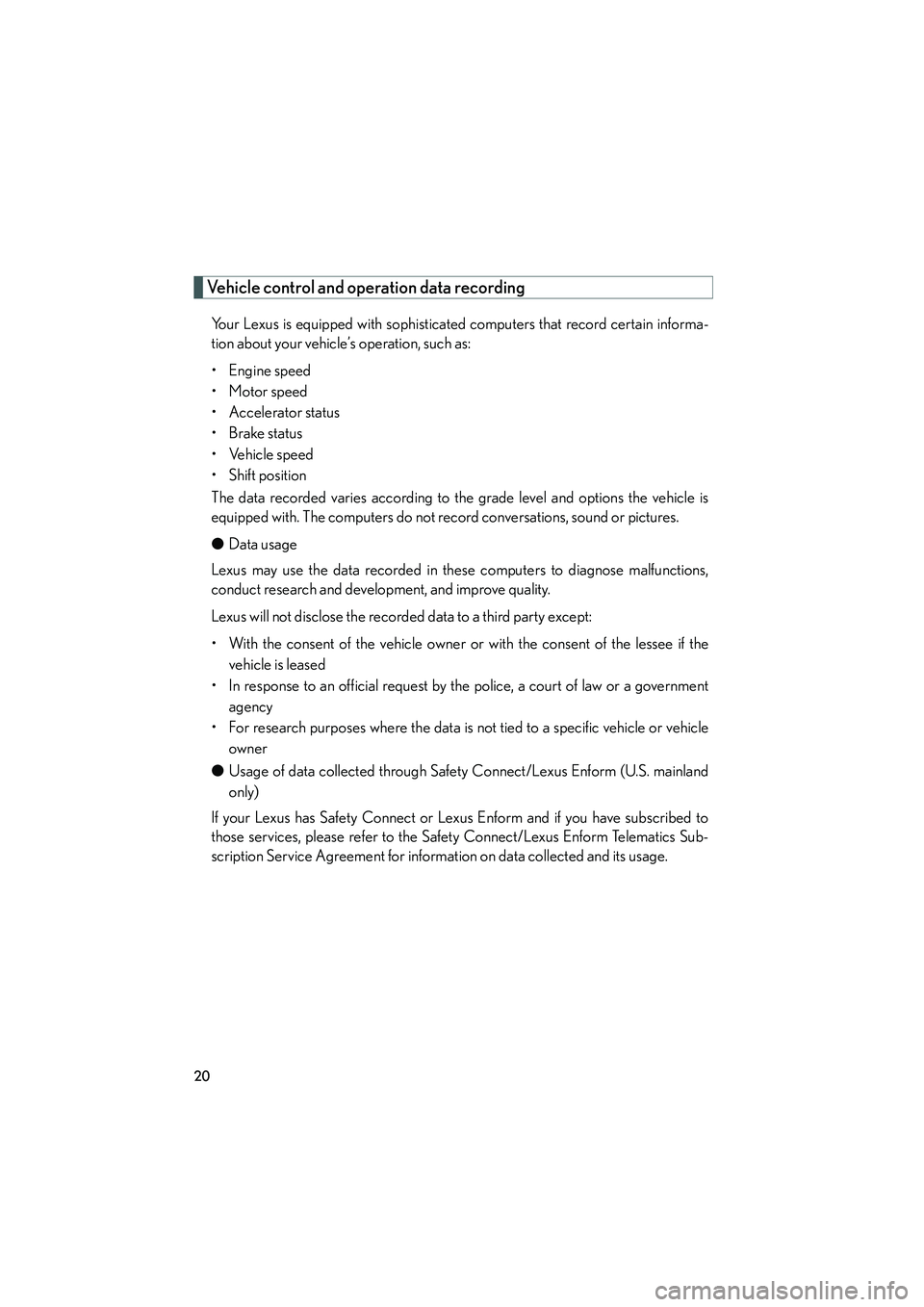
HS250h_U_75050U
20
Vehicle control and operation data recording
Your Lexus is equipped with sophisticated computers that record certain informa-
tion about your vehicle’s operation, such as:
• Engine speed
• Motor speed
• Accelerator status
• Brake status
• Vehicle speed
•Shift position
The data recorded varies according to the grade level and options the vehicle is
equipped with. The computers do not record conversations, sound or pictures.
● Data usage
Lexus may use the data recorded in these computers to diagnose malfunctions,
conduct research and development, and improve quality.
Lexus will not disclose the recorded data to a third party except:
• With the consent of the vehicle owner or with the consent of the lessee if the vehicle is leased
• In response to an official request by the police, a court of law or a government agency
• For research purposes where the data is not tied to a specific vehicle or vehicle owner
● Usage of data collected through Safety Connect/Lexus Enform (U.S. mainland
only)
If your Lexus has Safety Connect or Lexus Enform and if you have subscribed to
those services, please refer to the Safety Connect/Lexus Enform Telematics Sub-
scription Service Agreement for information on data collected and its usage.
Page 22 of 630
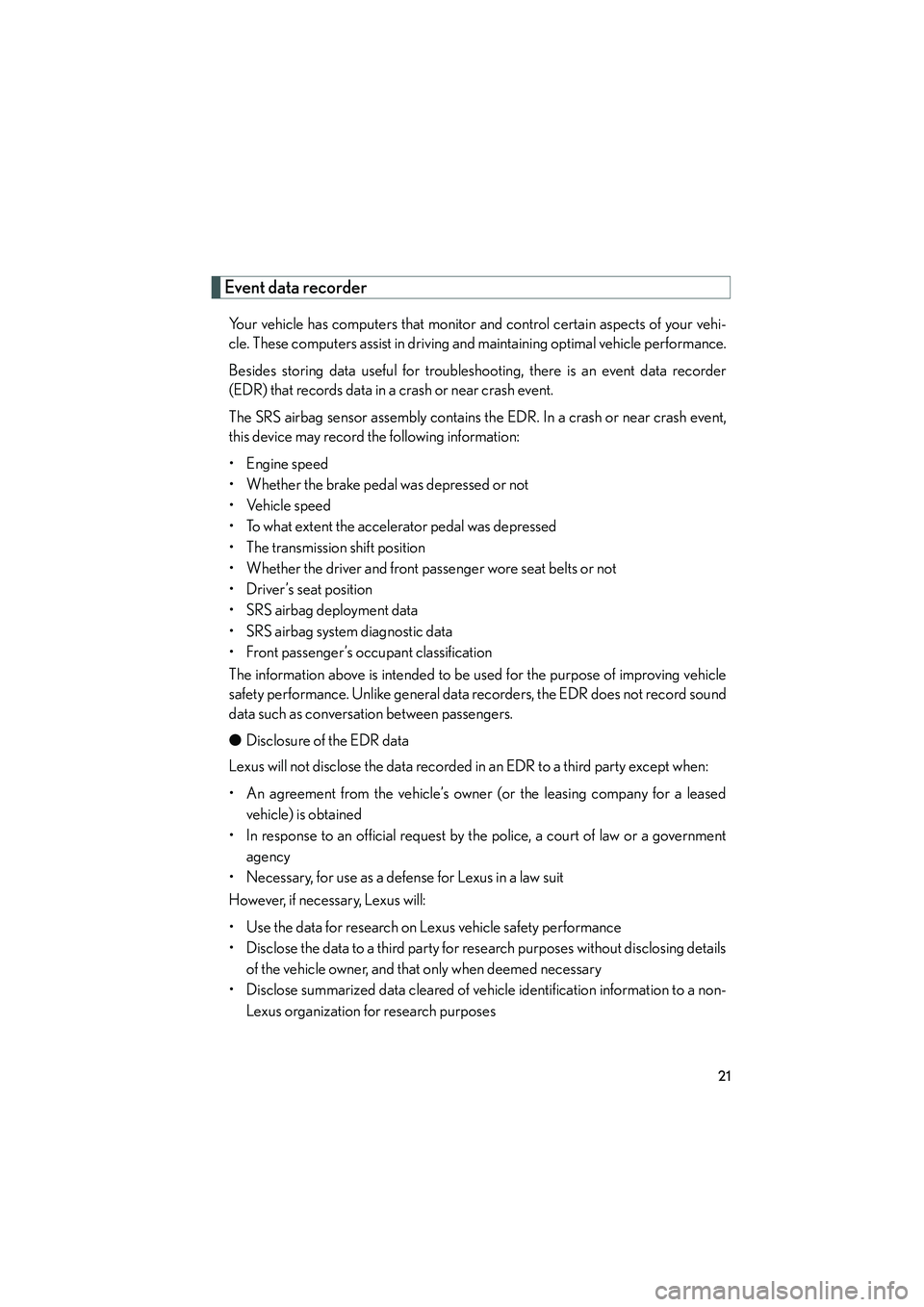
HS250h_U_75050U
21
Event data recorder
Your vehicle has computers that monitor and control certain aspects of your vehi-
cle. These computers assist in driving and maintaining optimal vehicle performance.
Besides storing data useful for troubleshooting, there is an event data recorder
(EDR) that records data in a crash or near crash event.
The SRS airbag sensor assembly contains the EDR. In a crash or near crash event,
this device may record the following information:
• Engine speed
• Whether the brake pedal was depressed or not
•Vehicle speed
• To what extent the accelerator pedal was depressed
• The transmission shift position
• Whether the driver and front passenger wore seat belts or not
• Driver’s seat position
• SRS airbag deployment data
• SRS airbag system diagnostic data
• Front passenger’s occupant classification
The information above is intended to be used for the purpose of improving vehicle
safety performance. Unlike general data recorders, the EDR does not record sound
data such as conversation between passengers.
●Disclosure of the EDR data
Lexus will not disclose the data recorded in an EDR to a third party except when:
• An agreement from the vehicle’s owner (or the leasing company for a leased vehicle) is obtained
• In response to an official request by the police, a court of law or a government agency
• Necessary, for use as a defense for Lexus in a law suit
However, if necessary, Lexus will:
• Use the data for research on Lexus vehicle safety performance
• Disclose the data to a third party for research purposes without disclosing details of the vehicle owner, and that only when deemed necessary
• Disclose summarized data cleared of vehicle identification information to a non-
Lexus organization for research purposes
Page 23 of 630
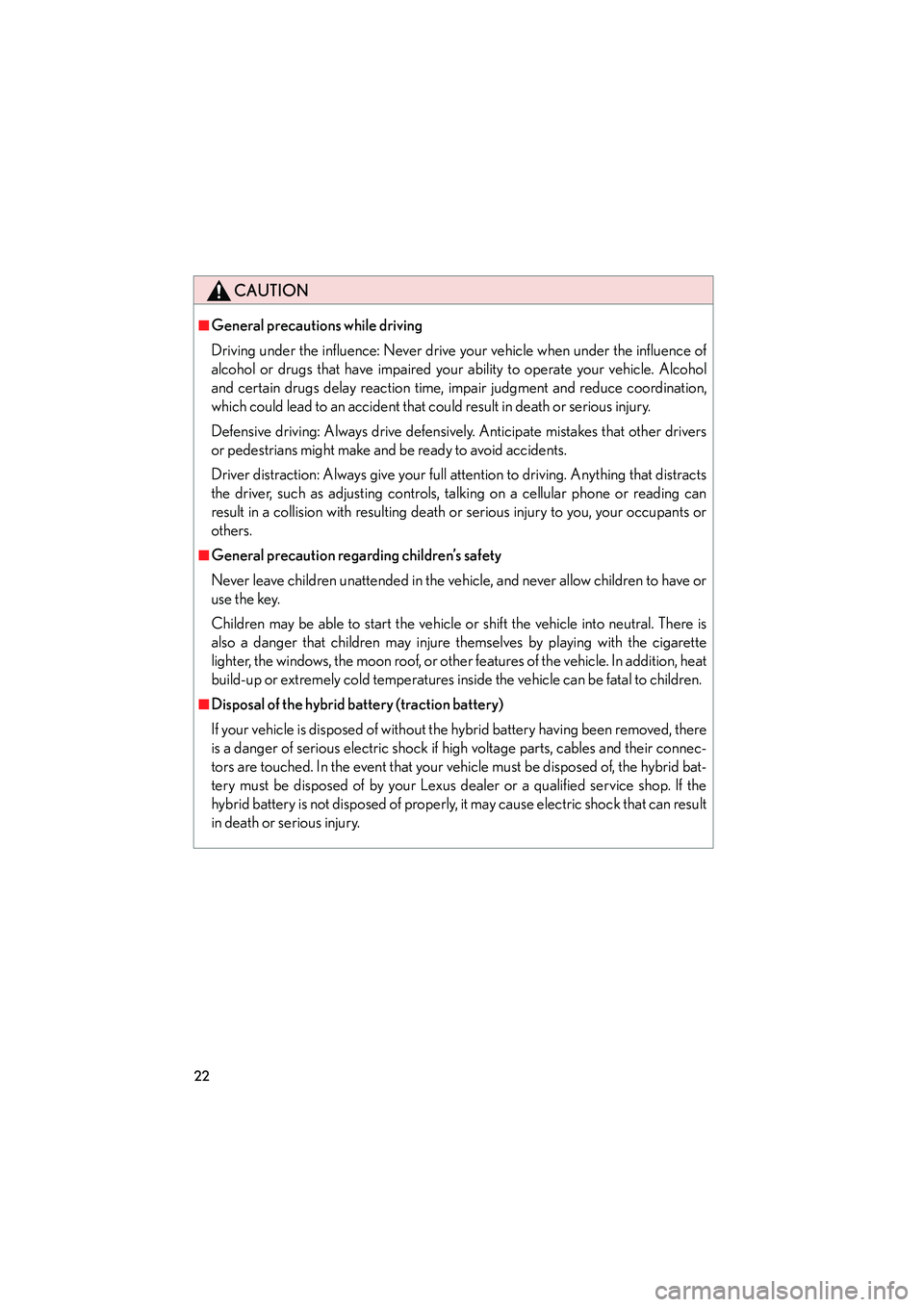
HS250h_U_75050U
22
CAUTION
■General precautions while driving
Driving under the influence: Never drive your vehicle when under the influence of
alcohol or drugs that have impaired your ability to operate your vehicle. Alcohol
and certain drugs delay reaction time, impair judgment and reduce coordination,
which could lead to an accident that could result in death or serious injury.
Defensive driving: Always drive defensively. Anticipate mistakes that other drivers
or pedestrians might make and be ready to avoid accidents.
Driver distraction: Always give your full attention to driving. Anything that distracts
the driver, such as adjusting controls, talking on a cellular phone or reading can
result in a collision with resulting death or serious injury to you, your occupants or
others.
■General precaution regarding children’s safety
Never leave children unattended in the vehicle, and never allow children to have or
use the key.
Children may be able to start the vehicle or shift the vehicle into neutral. There is
also a danger that children may injure themselves by playing with the cigarette
lighter, the windows, the moon roof, or other features of the vehicle. In addition, heat
build-up or extremely cold temperatures inside the vehicle can be fatal to children.
■Disposal of the hybrid battery (traction battery)
If your vehicle is disposed of without the hybrid battery having been removed, there
is a danger of serious electric shock if high voltage parts, cables and their connec-
tors are touched. In the event that your vehicle must be disposed of, the hybrid bat-
tery must be disposed of by your Lexus dealer or a qualified service shop. If the
hybrid battery is not disposed of properly, it may cause electric shock that can result
in death or serious injury.
Page 24 of 630
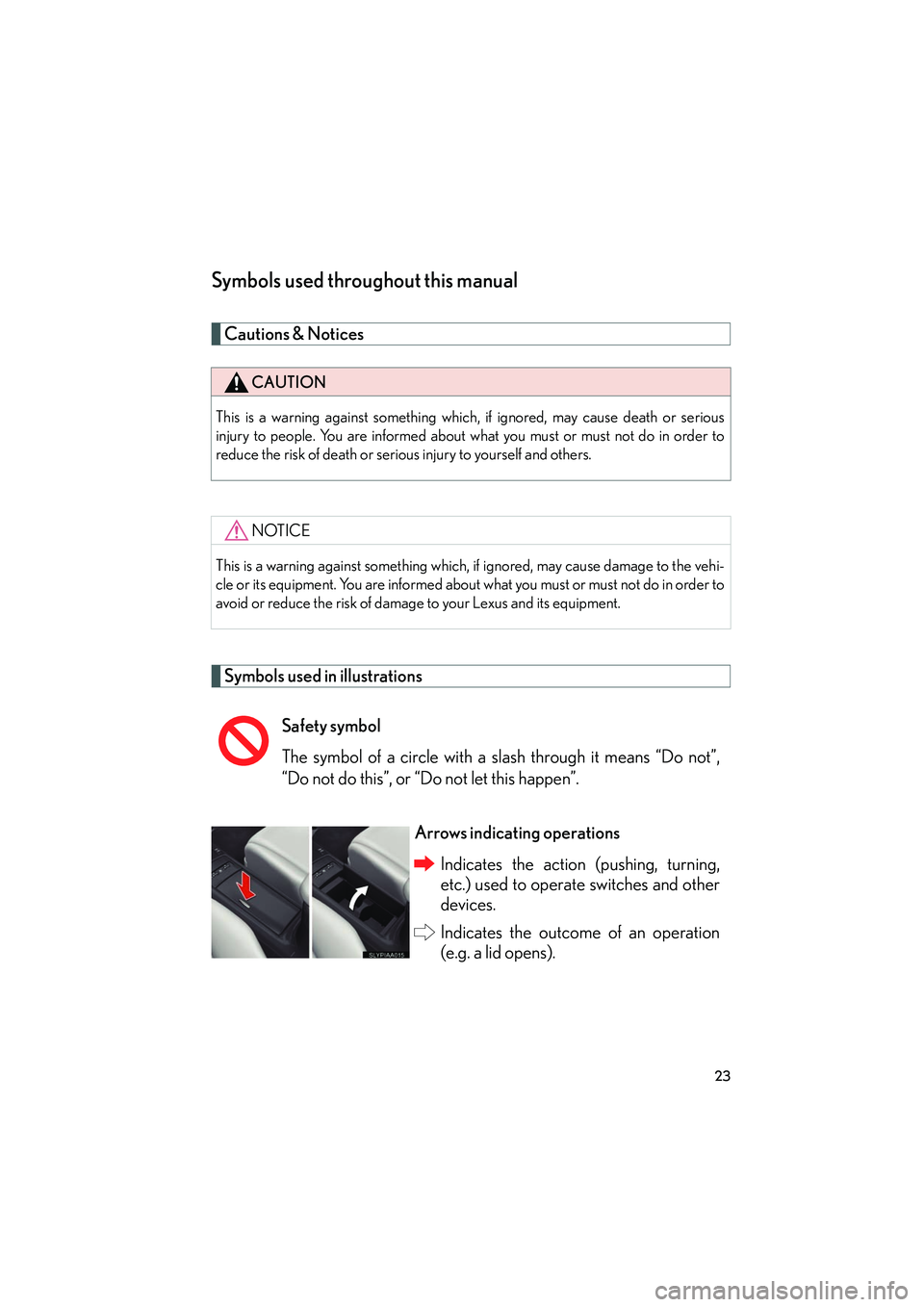
HS250h_U_75050U
23
Symbols used throughout this manual
Cautions & Notices
Symbols used in illustrations
CAUTION
This is a warning against something which, if ignored, may cause death or serious
injury to people. You are informed about what you must or must not do in order to
reduce the risk of death or serious injury to yourself and others.
NOTICE
This is a warning against something which, if ignored, may cause damage to the vehi-
cle or its equipment. You are informed about what you must or must not do in order to
avoid or reduce the risk of damage to your Lexus and its equipment.
Safety symbol
The symbol of a circle with a slash through it means “Do not”,
“Do not do this”, or “Do not let this happen”.Arrows indicating operationsIndicates the action (pushing, turning,
etc.) used to operate switches and other
devices.
Indicates the outcome of an operation
(e.g. a lid opens).
Page 25 of 630

HS250h_U_75050U
24
Page 26 of 630
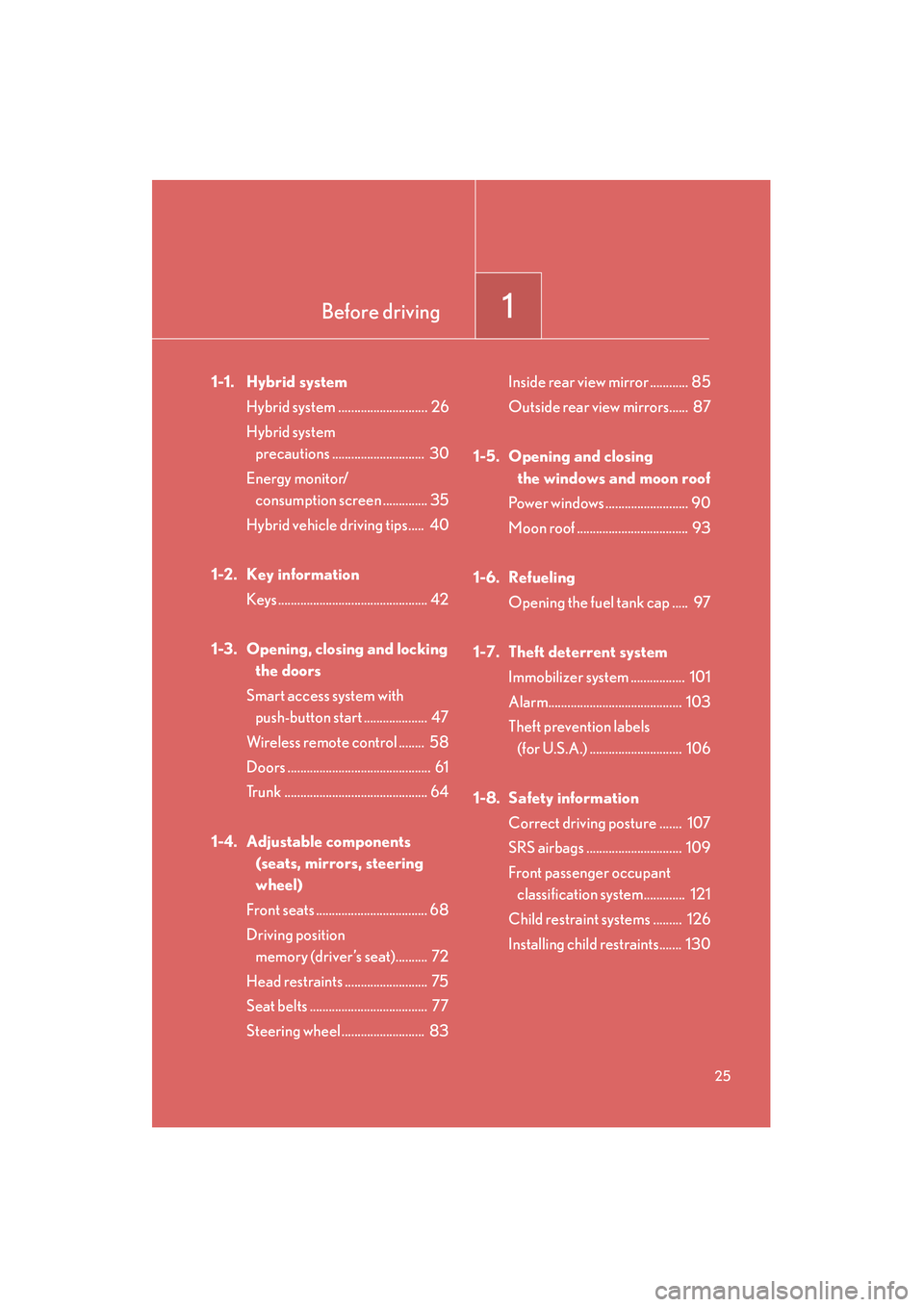
Before driving1
25
HS250h_U_75050U
1-1. Hybrid systemHybrid system ............................ 26
Hybrid system precautions ............................. 30
Energy monitor/ consumption screen .............. 35
Hybrid vehicle driving tips..... 40
1-2. Key information Keys ............................................... 42
1-3. Opening, closing and locking the doors
Smart access system with push-button start .................... 47
Wireless remote control ........ 58
Doors ............................................. 61
Trunk ............................................. 64
1-4. Adjustable components (seats, mirrors, steering
wheel)
Front seats ................................... 68
Driving position memory (driver’s seat).......... 72
Head restraints .......................... 75
Seat belts ..................................... 77
Steering wheel .......................... 83 Inside rear view mirror ............ 85
Outside rear view mirrors...... 87
1-5. Opening and closing the windows and moon roof
Power windows .......................... 90
Moon roof ................................... 93
1-6. Refueling Opening the fuel tank cap ..... 97
1-7. Theft deterrent system Immobilizer system ................. 101
Alarm.......................................... 103
Theft prevention labels (for U.S.A.) ............................. 106
1-8. Safety information Correct driving posture ....... 107
SRS airbags .............................. 109
Front passenger occupant classification system............. 121
Child restraint systems ......... 126
Installing child restraints....... 130
Page 27 of 630
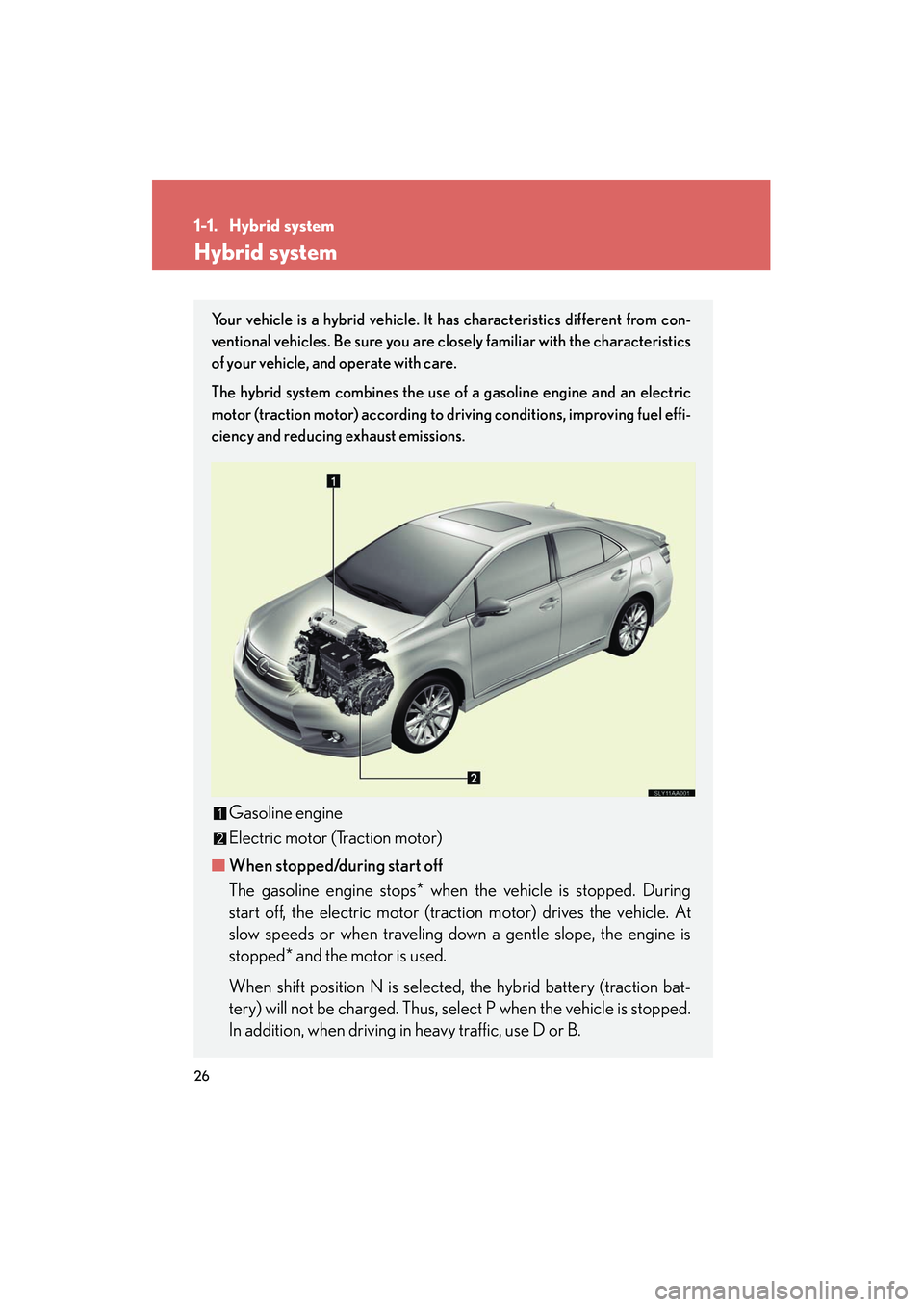
26
HS250h_U_75050U
1-1. Hybrid system
Hybrid system
Your vehicle is a hybrid vehicle. It has characteristics different from con-
ventional vehicles. Be sure you are closely familiar with the characteristics
of your vehicle, and operate with care.
The hybrid system combines the use of a gasoline engine and an electric
motor (traction motor) according to driving conditions, improving fuel effi-
ciency and reducing exhaust emissions.
Gasoline engine
Electric motor (Traction motor)
■ When stopped/during start off
The gasoline engine stops* when the vehicle is stopped. During
start off, the electric motor (traction motor) drives the vehicle. At
slow speeds or when traveling down a gentle slope, the engine is
stopped* and the motor is used.
When shift position N is selected, the hybrid battery (traction bat-
tery) will not be charged. Thus, select P when the vehicle is stopped.
In addition, when driving in heavy traffic, use D or B.
Page 28 of 630
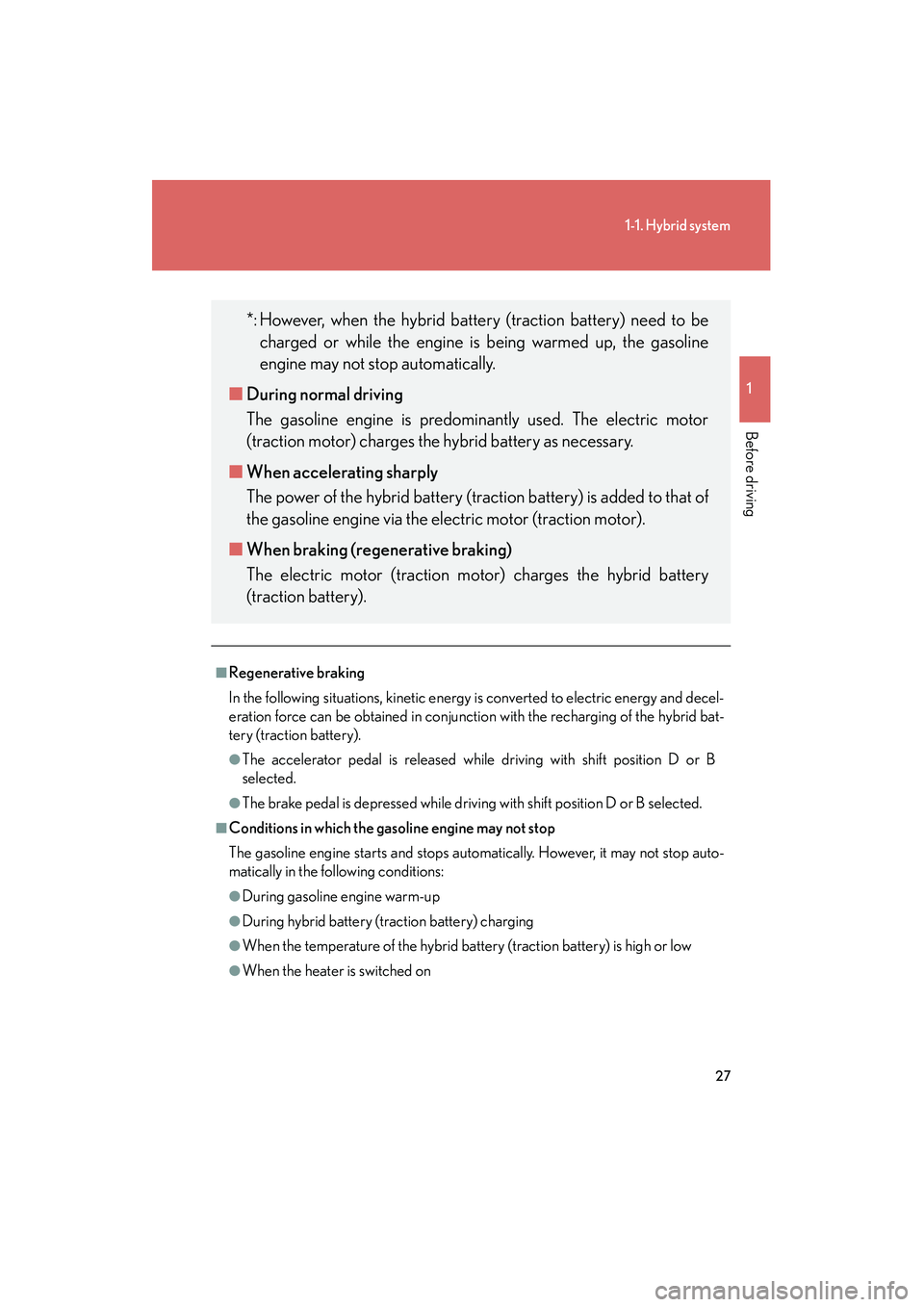
27
1-1. Hybrid system
1
Before driving
HS250h_U_75050U
■Regenerative braking
In the following situations, kinetic energy is converted to electric energy and decel-
eration force can be obtained in conjunction with the recharging of the hybrid bat-
tery (traction battery).
●The accelerator pedal is released while driving with shift position D or B
selected.
●The brake pedal is depressed while driving with shift position D or B selected.
■Conditions in which the gasoline engine may not stop
The gasoline engine starts and stops automatically. However, it may not stop auto-
matically in the following conditions:
●During gasoline engine warm-up
●During hybrid battery (traction battery) charging
●When the temperature of the hybrid battery (traction battery) is high or low
●When the heater is switched on
*: However, when the hybrid battery (traction battery) need to becharged or while the engine is being warmed up, the gasoline
engine may not stop automatically.
■ During normal driving
The gasoline engine is predominantly used. The electric motor
(traction motor) charges the hybrid battery as necessary.
■ When accelerating sharply
The power of the hybrid battery (traction battery) is added to that of
the gasoline engine via the electric motor (traction motor).
■ When braking (regenerative braking)
The electric motor (traction motor) charges the hybrid battery
(traction battery).
Page 29 of 630
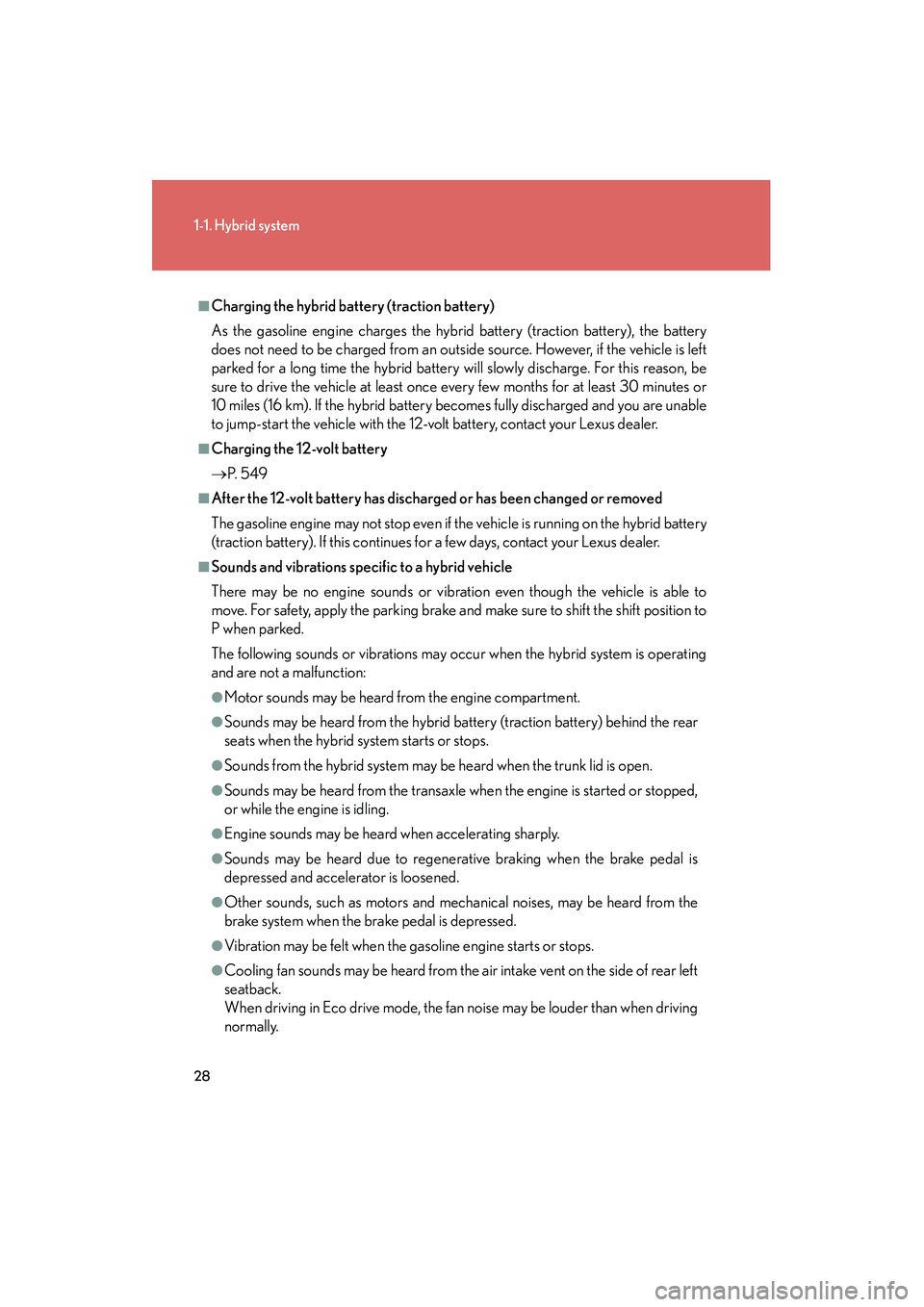
28
1-1. Hybrid system
HS250h_U_75050U
■Charging the hybrid battery (traction battery)
As the gasoline engine charges the hybrid battery (traction battery), the battery
does not need to be charged from an outside source. However, if the vehicle is left
parked for a long time the hybrid battery will slowly discharge. For this reason, be
sure to drive the vehicle at least once every few months for at least 30 minutes or
10 miles (16 km). If the hybrid battery becomes fully discharged and you are unable
to jump-start the vehicle with the 12-volt battery, contact your Lexus dealer.
■Charging the 12-volt battery
→P. 5 4 9
■After the 12-volt battery has discharg ed or has been changed or removed
The gasoline engine may not stop even if the vehicle is running on the hybrid battery
(traction battery). If this continues for a few days, contact your Lexus dealer.
■Sounds and vibrations specific to a hybrid vehicle
There may be no engine sounds or vibration even though the vehicle is able to
move. For safety, apply the parking brake and make sure to shift the shift position to
P when parked.
The following sounds or vibrations may occur when the hybrid system is operating
and are not a malfunction:
●Motor sounds may be heard from the engine compartment.
●Sounds may be heard from the hybrid battery (traction battery) behind the rear
seats when the hybrid system starts or stops.
●Sounds from the hybrid system may be heard when the trunk lid is open.
●Sounds may be heard from the transaxle when the engine is started or stopped,
or while the engine is idling.
●Engine sounds may be heard when accelerating sharply.
●Sounds may be heard due to regenerative braking when the brake pedal is
depressed and accelerator is loosened.
●Other sounds, such as motors and mechanical noises, may be heard from the
brake system when the brake pedal is depressed.
●Vibration may be felt when the gasoline engine starts or stops.
●Cooling fan sounds may be heard from the air intake vent on the side of rear left
seatback.
When driving in Eco drive mode, the fan noise may be louder than when driving
normally.
Page 30 of 630

29
1-1. Hybrid system
1
Before driving
HS250h_U_75050U
■Maintenance, repair, recycling, and disposal
Contact your Lexus dealer regarding maintenance, repair, recycling and disposal.
Do not dispose of the vehicle yourself.